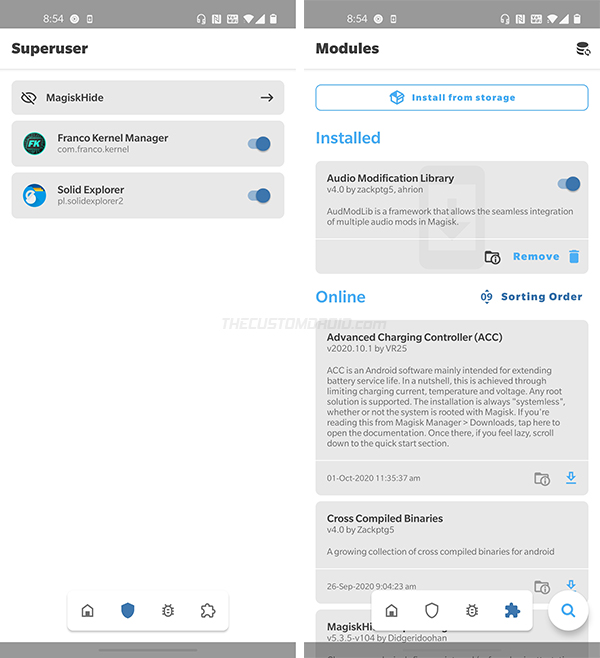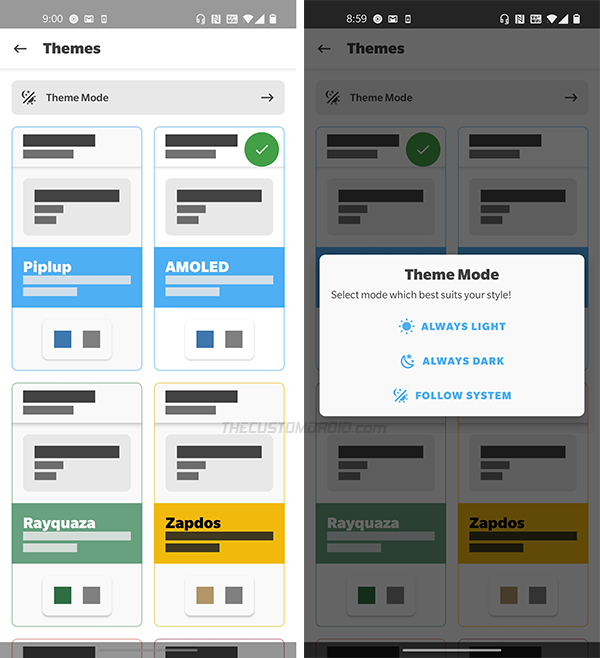After months since the last stable release, developer John Wu has now announced the Magisk v21 update. This stable and latest version of Magisk brings full Android 11 support, Pixel 5 and Pixel 4a 5G support, safe mode detection for fixing boot loops caused by modules, a new SELinux policy for devices running Android 8.0+, a completely redesigned Magisk Manager UI, and a lot more.
Advertisement
You can now download Magisk v21.4 with Magisk Manager v8.0.7 and install it on your Android device. Users running a previous version can easily update to the latest version of Magisk by following the instructions provided on this page.
Update #9 (23 February): Magisk v22 has been released. It merges core Magisk and Magisk Manager into one single release as an APK file, which is also apparently a flashable ZIP.
Update #8 (17 January): Since the last release just a day ago, Magisk is now updated to v21.4 to an issue that causes several root apps to break. This release is accompanied by v8.0.7 of Magisk Manager that fixes the SEPolicy rule migration when updating. (Source)
Update #7 (16 January): Magisk 21.3 has been released. It fixes a bug related to F2FS drivers in the Linux kernel that caused widespread bootloops and module instability on a lot of devices. Here’s a summary posted by John Wu on Twitter. The latest release is accompanied by Magisk Manager 8.0.6 with minor UI tweaks and updated internal scripts. (Source)
Update #6 (12 January): Magisk v21 has been pushed to the Stable channel now. Users running the beta release do not need to reinstall it because no new changes were made. The developer has also released Magisk Manager 8.0.5 with a minor fix. (Source)
Update #5: Developer John Wu has released Magisk 21.2 and Magisk Manager v8.0.4 with minor changes and bug fixes. This will presumably the last release of v21 and will be pushed to the Stable update channel if everything goes well.
Update #4: Magisk v21.1 with Magisk Manager v8.0.3 has been released with support for Pixel 5 and Pixel 4a 5G, and several bug fixes.
Update #3: Just a day after the previous release, John Wu has now released Magisk Manager v8.0.2. This fixes permission requesting on devices running Android 10 and below. It also moves more files to the new CDN for faster and more reliable downloads.
Update #2: Magisk Manager v8.0.1 has been released. This new version fixes vbmeta.img patching for Samsung AP.tar files. This fixes boot loops on Samsung Galaxy devices after flashing updated AP firmware files.
Update #1: According to developer John Wu, recent reports indicate that Magisk 21.0 does not work on MediaTek Android devices.
Page Contents
What’s new in Magisk v21?
To recap, the previous release (Magisk 20.4) disabled Magisk Hide by default in light of the new hardware-backed SafetyNet attestation, BusyBox standalone mode, and introduced several other minor changes. Before you head over to the download links or instructions, let us take a look at some of the key changes that Magisk v21 brings.
Note: The changes below were originally written for v21.0 and have now been expanded with the new changes in the Magisk v21.4, v21.3, v21.2, and v21.1 updates.
Advertisement
1. Google Pixel 5/4a 5G Support
Up until now, Pixel 5 and Pixel 4a (5G) owners had to resort to Magisk Canary builds for gaining root access.
But now, Magisk 21.1 (and above) has been updated to use Boot Image Header version 3, thus adding support for the Pixel 5 and Pixel 4a 5G. If you’re a developer, the changes in the latest header version have been posted in the official documentation here.
2. Android 11 Support
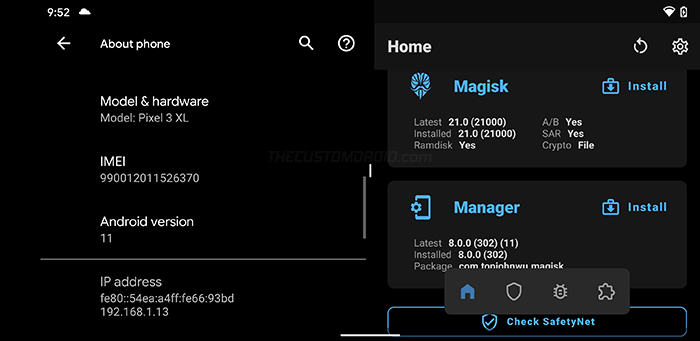
As you’d know, after months of testing, Google finally announced the stable Android 11 update a few months ago. Several device manufacturers are already begun publishing Android 11 beta builds for their devices, like the OnePlus 8 series. This certainly means that a lot of users are running Android 11 on their phones. For rooting enthusiasts, Magisk has already supported Android 11 on the Canary channel. With v21.0 (and above), Magisk now fully supports Android 11 on the stable channel. The developer has worked pretty hard to re-write a lot of Magisk code from the scratch.
Further, Magisk generally mounts and use the /tmpfs directory to store temporary data. According to the developer, the /sbin sub-directory may no longer be available in Android 11. So, on devices running Android 11, Magisk will automatically create a random folder inside /dev and use it as PATH. Developers could find everything about this change in the official documentation here.
In terms of Android 11 support, Magisk v21 also fixes an issue wherein Magisk was removed after a factory data reset.
2. Redesigned Magisk Manager UI
Earlier last year, developer John Wu showcased a preview of a completely new design of the Magisk Manager application, courtesy of Viktor De Pasquale (@diareuse). For months, users running Magisk Canary have had the privilege to enjoy this new UI. With Magisk Manager v8.0.2, the newly redesigned UI is now available for users on the stable channel as well.
Starting with the design itself, the old hamburger-based slide-out menu has been completely removed. It has been replaced with a minimal navigation bar towards the bottom end of the app. Items throughout the app’s interface are now showed in form of cards.
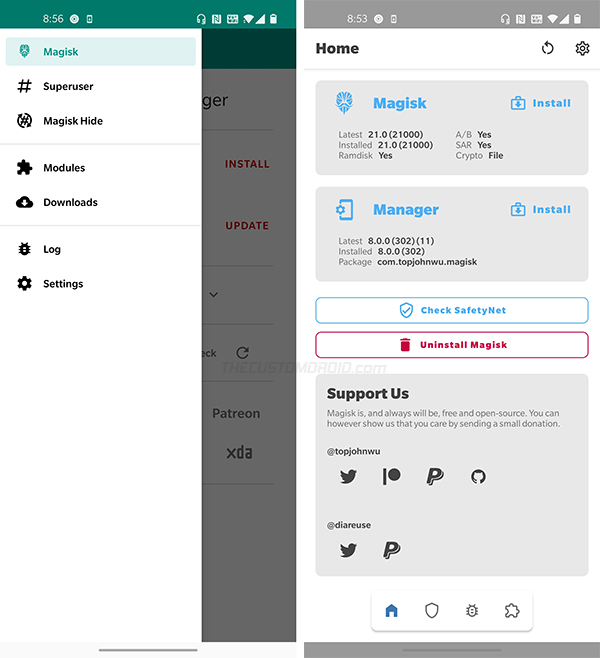
Individual sections of the app are rearranged for quicker access. For example, Magisk Hide (when enabled) is now shown under the ‘Superuser’ section instead of having its own dedicated section. Also in the old UI, downloading and managing modules were done from their own individual sections. With the new UI in Magisk Manager v8.0.2, you now have a unified ‘Modules’ section that allows you to manage (install, uninstall, and disable) and download Magisk modules from the same screen.
Advertisement
The new Magisk Manager also incorporates eight different color accent schemes and the ability to force light or dark theme modes.
Personally, we are not a huge fan of the card-based design in general, but Magisk Manager adapts it so well that we have no other choice but to adore it. Overall, this new user interface takes quite a huge leap over the previous one, in terms of both design and usability.
3. Safe Mode Detection
Boot loops caused by modules due to incompatibility is a common issue that a lot of users face. Up until now, users could either use TWRP or ADB to remove the rogue Magisk module(s) to fix the problem.
Developer John Wu was surely well aware of the issue and has brought us a simple solution. From Magisk 21.0 onwards, you could simply boot your Android device into Safe Mode. Magisk will detect Safe Mode and automatically disable all the Magisk modules. You could just reboot into the OS after this and the boot loop will be fixed.
4. New SELinux Policy Setup on Android 8.0+
The SELinux security has been hardened with a completely new policy setup for devices running Android 8.0 Oreo and above. This new policy now keeps the Android Sandbox less compromised, separates the Magisk policy rules from original rules, thus providing better security on devices rooted with Magisk.
5. F2FS Kernel Drivers Fix
Several users reportedly faced bootloop and module instability issues with Magisk v21. These were reported on Github. The issue has been fixed in Magisk v21.4 as developer John Wu was able to find the culprit. A newer Canary build has also been pushed for the respective users.
He pointed out that it was caused due to an F2FS driver bug in the Linux kernel. He further added that this bug only affected a specific Android kernel branch, which was the reason why not all devices were affected by the issue. As for stability issues with Magisk modules, only devices that used the modern F2FS drivers were affected.
Advertisement
So these were the major changes in the Magisk v21 update. For end-users, not a lot has changed except for the first two, i.e. Android 11 support and redesigned Magisk Manager. For developers, there are also some key changes made on how Magisk works. You would like to refer to the new changes in the official documentation here.
Changelogs
Magisk v21.4 Changelog
Below is the complete changelog for Magisk 21.4 as published by the developer on Github.
- [MagiskSU] Fix
su -cbehavior that broke many root apps - [General] Properly handle read/write over sockets (the
broken pipeissue)
Magisk Manager v8.0.7 Changelog
Below is the complete changelog for Magisk Manager 8.0.7 as published by the developer on Github.
- Fix sepolicy rule migration when upgrading
Download Magisk v21.4 & Magisk Manager v8.0.7 from Github
Like any previous release, Magisk v21.4 is available for download as a flashable ZIP file for those who want to install it via a custom recovery. Users who wish to install Magisk by patching the boot image can download the latest Magisk Manager v8.0.7 APK from below.
- Magisk 21.4 Flashable ZIP file:
- Installer: Magisk-v21.4.zip
- Uninstaller: Magisk-uninstaller-20210117.zip
- Magisk Manager 8.0.7 APK: MagiskManager-v8.0.7.apk
Previous Releases
Download Magisk v21.3 & Magisk Manager v8.0.6
- Magisk 21.3 Flashable ZIP file:
- Installer: Magisk-v21.3.zip
- Uninstaller: Magisk-uninstaller-20210116.zip
- Magisk Manager 8.0.6 APK: MagiskManager-v8.0.6.apk
Download Magisk v21.2 & Magisk Manager v8.0.5
- Magisk 21.2 Flashable ZIP file:
- Installer: Magisk-v21.2.zip
- Uninstaller: Magisk-uninstaller-20201228.zip
- Magisk Manager 8.0.5 APK: MagiskManager-v8.0.5.apk
Download Magisk v21.1 & Magisk Manager v8.0.3
Advertisement
- Flashable ZIPs
- Installer: Magisk-v21.1.zip
- Uninstaller: Magisk-uninstaller-20201113.zip
- APK: MagiskManager-v8.0.3.apk
Download Magisk 21.0 & Magisk Manager 8.0.2
- Flashable ZIPs
- Installer: Magisk-v21.0.zip
- Uninstaller: Magisk-uninstaller-20201003.zip
- APK: MagiskManager-v8.0.2.apk
If you are looking for a previous version of Magisk, check out the official Github release page.
How to Install Magisk v21.4 on Android
You can install the latest version of Magisk on your Android device using the following two ways/methods:
- By flashing the Magisk installer ZIP file using a custom recovery, such TWRP recovery.
- Or, by patching the boot/recovery image in Magisk Manager and then flashing the resultant patched boot image to your phone.
The first method is generally more straightforward and it’s what you should use if you have a custom recovery installed. On the other hand, if a custom recovery like TWRP is not available for your device, or if you don’t want to install a custom recovery at all, then simply follow the second method.
The second method also makes it much easier to install OTA updates on rooted devices using Magisk. All you will need is the stock boot/recovery image for the Android software version/build number currently installed on your device. You can extract these images from the OEM Factory Image or OTA update package (instructions here), try downloading it from firmware.mobi, or look up your device’s rooting guide on our website.
Before you install, it is strongly recommended to take a full backup of all your data before you begin installing Magisk. If any issues arise, this backup should help your restore all your data.
The following tutorial will help you install Magisk v21.4 using the aforementioned methods. We suggest you go through the instructions and familiarize yourself with the procedure before you start performing it.
— The Complete Step-by-Step Guide to Install Magisk on Android
How to Update to Magisk v21.4
If you have a previous version of Magisk installed on your device, then there’s no need to re-install it at all. You could simply update to Magisk v21.4 by using the Magisk Manager app. To do this:
- First, update the Magisk Manager app to the latest version by following the on-screen instructions.
- Alternatively, you can download Magisk Manager 8.0.7 and install the APK on your device.
- Now launch the Magisk Manager application on your device.
- Press the cogwheel icon on the top-right to access the “Settings” menu.
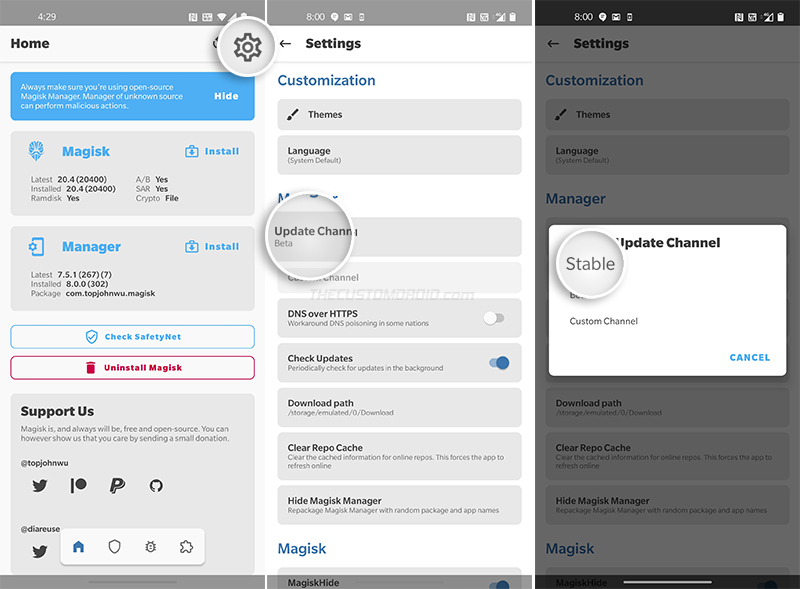
- Tap on “Update channel” and select “Stable”.
- Go back to the Magisk Manager home screen and wait for it to check for the latest version.
- Select “Update” and choose “Direct Install” as the installation method.
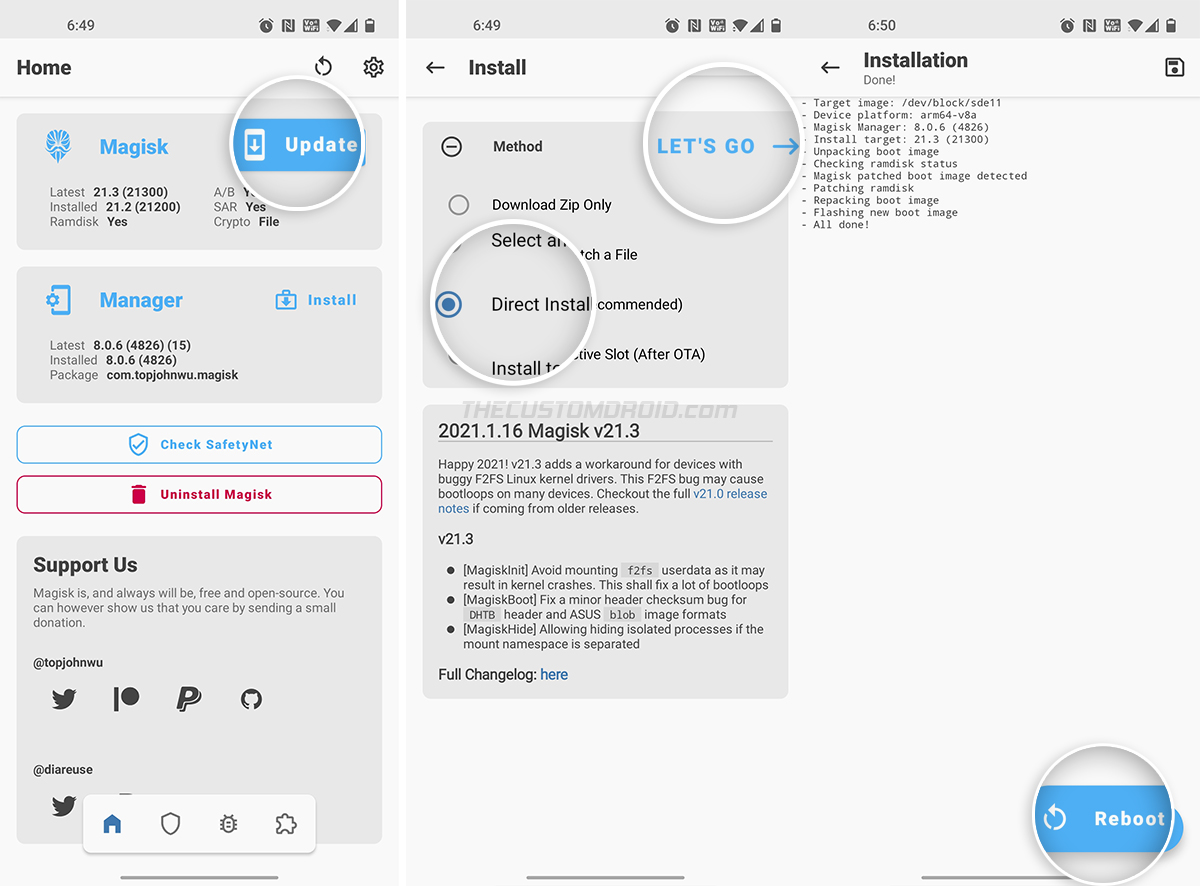
- Finally, select “LET’S GO” to confirm and install the Magisk v21.4 update on your device.
- Press the “Reboot” button after the installation finishes.
That’s it! So you were able to download Magisk v21.4 and install/update it on your phone. Don’t forget to browse through the redesigned Magisk Manager app to familiarize yourself with the new UI.
The developer has surely made some major improvements in this latest Magisk update, making it more secure for end-users, and easier for module/kernel developers out there. We highly appreciate his hard work and the time he has devoted to the Android community. If you have any questions about Magisk or its installation, feel free to let us know.
Source: Magisk on Github
